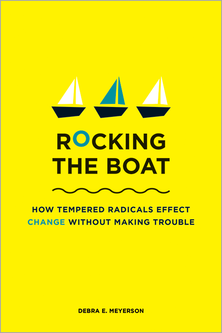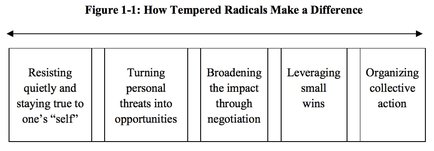Rocking The Boat

Task Zero: Review
For our Spring reading we were tasked with reading Debra Meyerson's Rocking the Boat to kick off our leadership strand work. In her researching her book, Meyerson conducted interviews with individuals at three different companies and other individuals who identified themselves as change agents. From these interview Meyerson found a common thread in the stories of women, minorities, LGBT individuals, and others who were able to make changes in their organizations without, as the title suggests, rock the boat. Meyerson refers to these individuals as tempered radicals.
Tempered radicals work "behind the scene" to gradually change an organization. There is the example of Peter Grant, an African American man, whom over his 20 years with a company was responsible for the hiring of more than 3,500 and creating support networks making it more possible for them to succeed. Tom Novak, an out gay man, decided to bring his partner to an event rather than bringing a female friend. These temper radicals make incremental change through a variety of means, celebrate the small wins, and make their organizations better places to work. Additionally, they empower others to start to make changes as well.
For our Spring reading we were tasked with reading Debra Meyerson's Rocking the Boat to kick off our leadership strand work. In her researching her book, Meyerson conducted interviews with individuals at three different companies and other individuals who identified themselves as change agents. From these interview Meyerson found a common thread in the stories of women, minorities, LGBT individuals, and others who were able to make changes in their organizations without, as the title suggests, rock the boat. Meyerson refers to these individuals as tempered radicals.
Tempered radicals work "behind the scene" to gradually change an organization. There is the example of Peter Grant, an African American man, whom over his 20 years with a company was responsible for the hiring of more than 3,500 and creating support networks making it more possible for them to succeed. Tom Novak, an out gay man, decided to bring his partner to an event rather than bringing a female friend. These temper radicals make incremental change through a variety of means, celebrate the small wins, and make their organizations better places to work. Additionally, they empower others to start to make changes as well.
Task One: How am I different?
Meyerson identifies three ways that people experience difference from the majority:
In many ways I fit into the dominant culture. I am phenotypically white, male, cisgender, and able-bodied. However, as a gay male in an interracial marriage I vacillate between feeling set apart from the mainstream and not excluded. I am lucky that in my current position my social identity is viewed as the majority of my colleagues as an asset the enriches the diversity of our building, there are others who make known their uneasiness with my refusal to hide my "self."
In the larger education community, I feel that being a proud, urban teacher is a philosophical difference. Urban education is often unfairly stigmatized as lacking in potential for innovation, as a “dead end” job, or something you do as a stepping stone to a job in a more affluent school. In fact, I have regularly been asked during my 10 years of teaching about when I plan on finally making the move to the suburbs.
Meyerson identifies three ways that people experience difference from the majority:
- Those who have different social identifies from the majority and see those differences as setting them apart and excluding them from the mainstream.
- Those who have different social identities and see those differences as merely cultural and not a basis for exclusion.
- Those who have not cultural but philosophical differences, which conflict with the prevailing values, beliefs and agendas operating in their organizations.
In many ways I fit into the dominant culture. I am phenotypically white, male, cisgender, and able-bodied. However, as a gay male in an interracial marriage I vacillate between feeling set apart from the mainstream and not excluded. I am lucky that in my current position my social identity is viewed as the majority of my colleagues as an asset the enriches the diversity of our building, there are others who make known their uneasiness with my refusal to hide my "self."
In the larger education community, I feel that being a proud, urban teacher is a philosophical difference. Urban education is often unfairly stigmatized as lacking in potential for innovation, as a “dead end” job, or something you do as a stepping stone to a job in a more affluent school. In fact, I have regularly been asked during my 10 years of teaching about when I plan on finally making the move to the suburbs.

Task Two: Becoming a Tempered Radical
In Figure 1-1 (p.8), Meyerson maps out a continuum of how tempered radicals make a difference. Over the years I can see how I have been slowly moving from the left to the right-hand side. For example, when I first started teaching I chose to ignore the homophobic comments I heard from coworkers and administrators. I knew who I was and that was enough for me at the time.
While I luckily no longer have endure those comments in my current position, there are the occasional microaggressions that I am able to turn into opportunities to inform my colleagues and students of their prejudices. While I have experienced small wins (developing a STEM program, finding paid internships for senior students) my goal as prepare to leave the classroom and enter a principalship is to use my position to leverage more small wins and start to organize collective action in partnership with other schools in the district.
In Figure 1-1 (p.8), Meyerson maps out a continuum of how tempered radicals make a difference. Over the years I can see how I have been slowly moving from the left to the right-hand side. For example, when I first started teaching I chose to ignore the homophobic comments I heard from coworkers and administrators. I knew who I was and that was enough for me at the time.
While I luckily no longer have endure those comments in my current position, there are the occasional microaggressions that I am able to turn into opportunities to inform my colleagues and students of their prejudices. While I have experienced small wins (developing a STEM program, finding paid internships for senior students) my goal as prepare to leave the classroom and enter a principalship is to use my position to leverage more small wins and start to organize collective action in partnership with other schools in the district.
Task Three: Facing Challenges
Meyerson describes four strains that tempered radicals cope with:
I have definitely felt the toll of loneliness due to my dual position as an insider based on my social identity and role as a midlevel leader in the school. This has increased over the years since "the higher people rise, the more distance they put between themselves and other 'outsiders' like themselves." (p.145) In order to resist this strain I have made a concerted effort to cultivate relationships with other outsiders in my school, district, and elsewhere through Twitter chats.
Additionally, I have removed my earrings and have started to wear more professional attire to present a more polished persona. I often joke that my past self wouldn't recognize my current self. However, I make it a point find ways both inside and outside of work to express this "old" self.
Lastly, with the current climate in the district frustration and burnout is a huge problem. There are days I feel like the various initiatives I have been working are at a stand-still or have even lost ground. During these moments I take a step back and focus on my students. They have the ability to calm me down, remind me of the small wins I have made over the years, and give me the strength to keep pushing forward.
Meyerson describes four strains that tempered radicals cope with:
- the difficulties of ambivialance
- the incremental lures of co-optation
- potential damage to their reputation
- frustration and burnout
I have definitely felt the toll of loneliness due to my dual position as an insider based on my social identity and role as a midlevel leader in the school. This has increased over the years since "the higher people rise, the more distance they put between themselves and other 'outsiders' like themselves." (p.145) In order to resist this strain I have made a concerted effort to cultivate relationships with other outsiders in my school, district, and elsewhere through Twitter chats.
Additionally, I have removed my earrings and have started to wear more professional attire to present a more polished persona. I often joke that my past self wouldn't recognize my current self. However, I make it a point find ways both inside and outside of work to express this "old" self.
Lastly, with the current climate in the district frustration and burnout is a huge problem. There are days I feel like the various initiatives I have been working are at a stand-still or have even lost ground. During these moments I take a step back and focus on my students. They have the ability to calm me down, remind me of the small wins I have made over the years, and give me the strength to keep pushing forward.
Works Cited
Meyerson, D. E. (2008). Rocking the boat: How to effect change without making trouble. Harvard Business Press.
Meyerson, D. E. (2008). Rocking the boat: How to effect change without making trouble. Harvard Business Press.